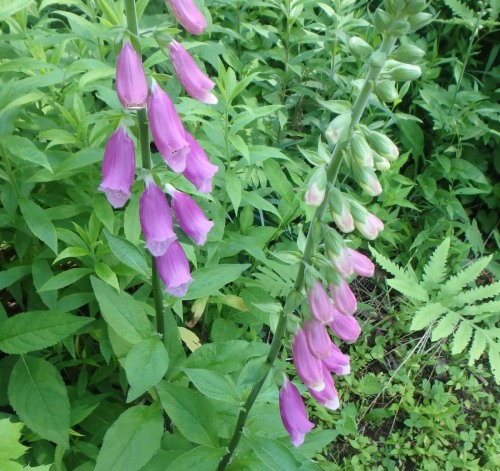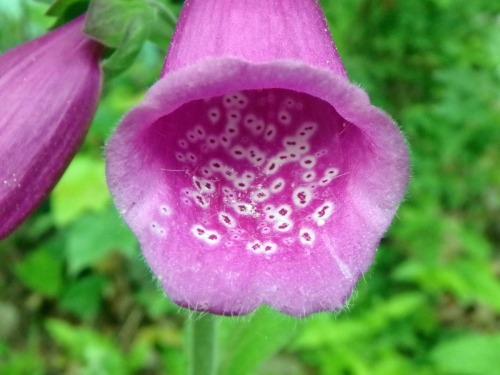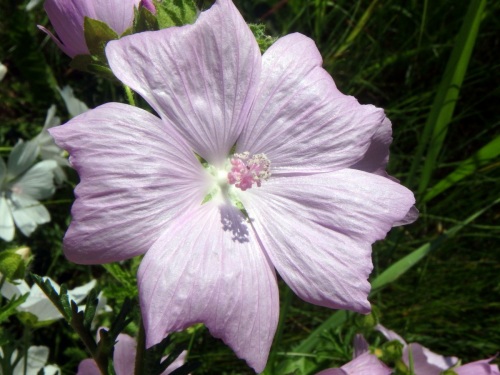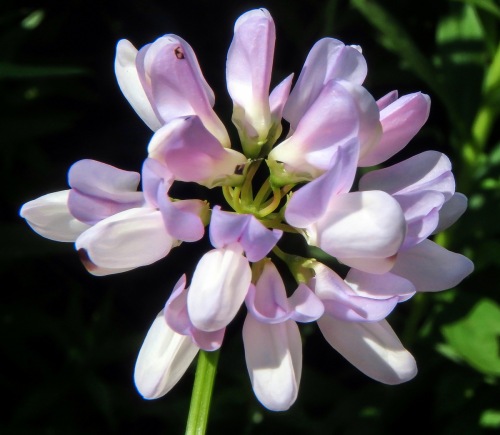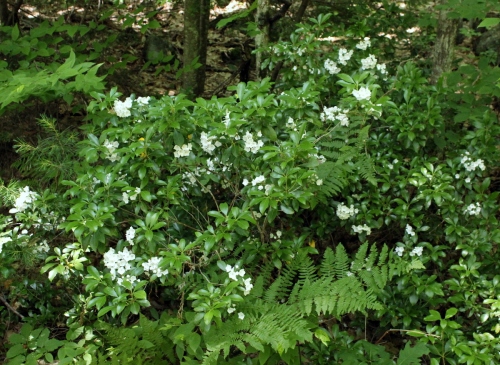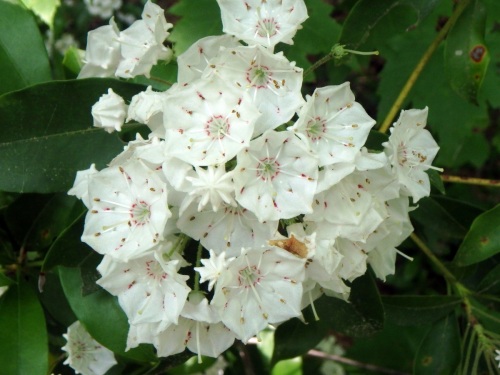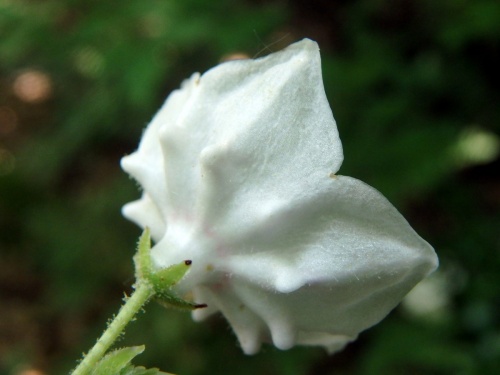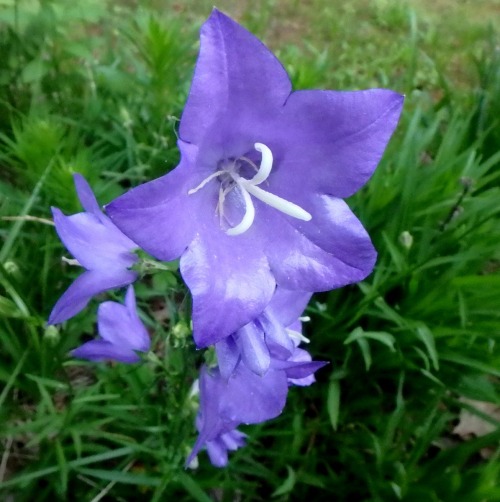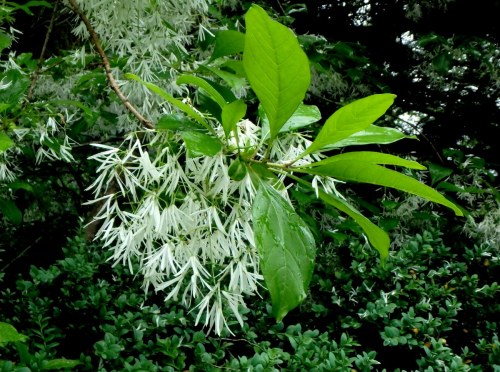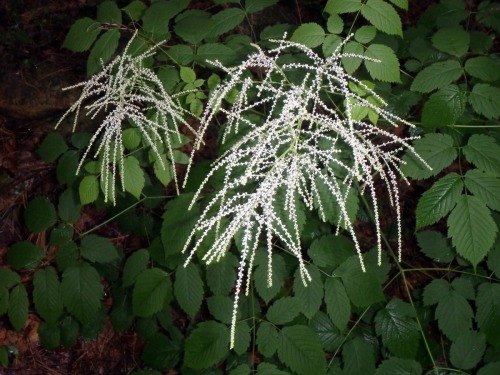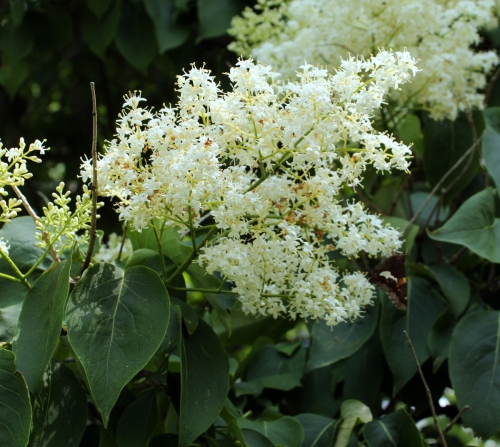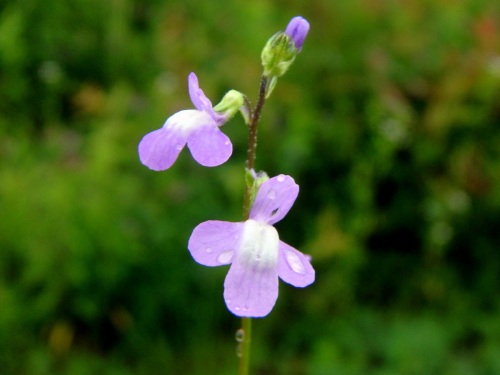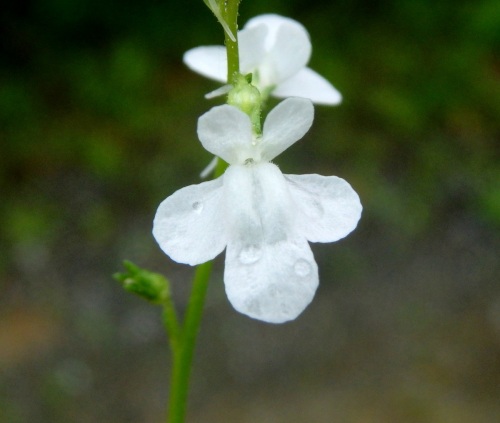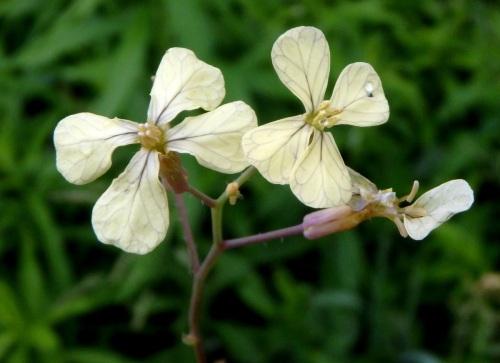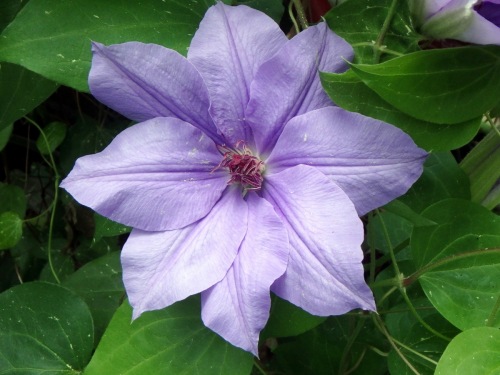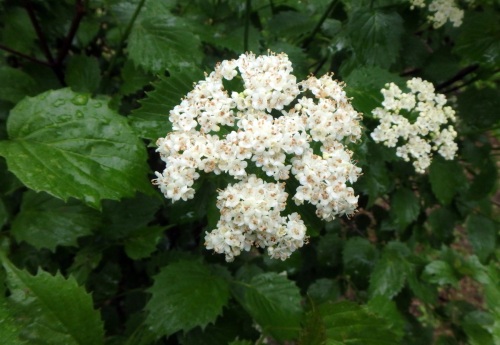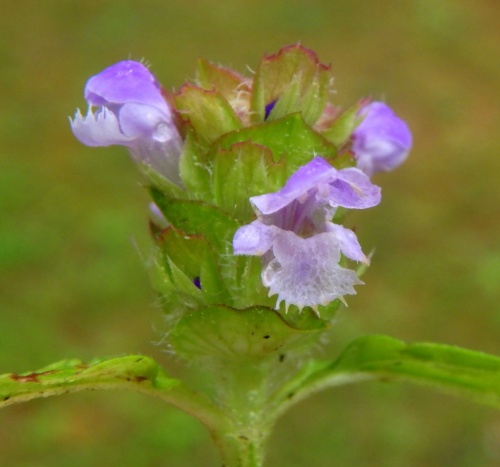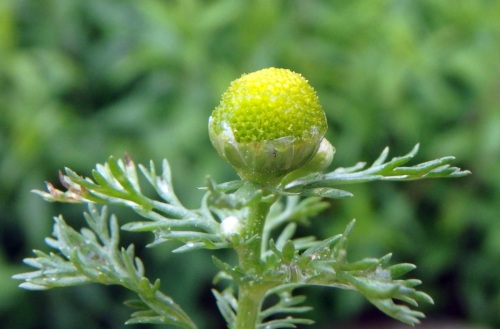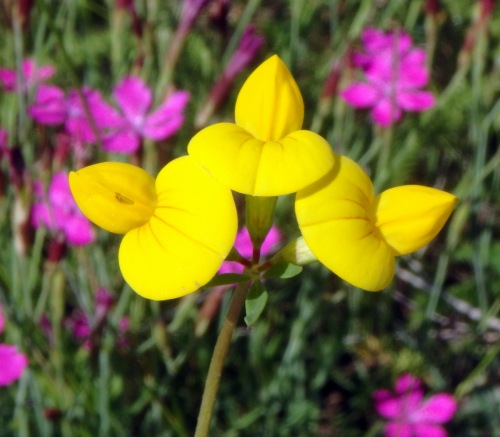Foxglove (Digitalis purpurea) is not a native plant so I’m always surprised to see it growing along the edge of forests. I don’t see it in the wild often but it seems to escape gardens and find places that suit its temperament and there it stays, sometimes forming small colonies. I’ve also seen one or two older, large colonies which were very beautiful.
I like to try to get a bee’s eye view of foxglove blossoms. They apparently start life with yellow spots which turn to white as they age. The lower lip protrudes a bit to give bees a landing pad, and from there they follow the spots, which are nectar guides, up to the top of the blossom where they find the nectar. While the bee is busy with the nectar the anthers above it rub on its back and deposit the flower’s pollen, which will then be taken to another blossom. If successfully pollinated a foxglove plant can produce from one to two million very small seeds.
I find mallow plants (Malvaceae) growing in strange places like on roadsides as this one was but I think most are escapees from someone’s garden. The flowers on this example look a lot like those of vervain mallow (Malva alcea), which is a European import. Like all plants in the mallow family its flowers were large and beautiful. I like its wrinkled petals, which look like they were cut from crepe paper. Other well-known plants in this family include hibiscus, hollyhocks, and rose of Sharon.
Crown vetch (Securigera varia) has just come into bloom and I’m happy to see it because I think it’s a beautiful flower even if it is invasive. It’s one of those that often seem to glow with their own inner light and I enjoy just looking at it for a time. Crown vetch has seed pods look that like axe heads and English botanist John Gerard called the plant axewort and axeseed in 1633. It is thought that its seeds somehow ended up in other imported plant material because the plant was found in New York in 1869. By 1872 it had become naturalized in New York and now it is in every state in the country except Alaska.
June is when our native mountain laurel (Kalmia latifolia) blooms and you can see certain roads that are lined with the glossy leaved, white flowering shrubs. They seem fussy about where they grow but when they find a spot that they like they can form dense thickets that are nearly impossible to get through. In this spot they grow to about 10 feet tall.
The pentagonal flowers of mountain laurel are very unusual because each has ten pockets in which the male anthers rest under tension. When a heavy enough insect lands on a blossom the anthers spring from their pockets and dust it with pollen. You can see some relaxed anthers in this photo. Once the anthers are released from their pockets they don’t return to them.
What once may have been five petals are now fused into a single, cup shaped blossom. A side view of a single mountain laurel blossom shows the unusual pockets that the anthers rest in. Another old name for mountain laurel is spoon wood, because Native Americans used the tough wood to make spoons and other small utensils.
This plant goes by many common names but I’ve always called it peach leaved bluebells (Campanula persicifolia) which comes from its leaves resembling those of the peach tree. It is very easy to grow; literally a “plant it and forget it” perennial. I planted one in my garden years ago and not only is it still growing, but many seedlings from it are also growing all over the yard. I usually give several away each summer to family and friends. It’s a good choice for someone just starting a garden.
Fringe trees (Chionanthus virginicus) might look like an exotic import from China or Japan but they’re native to the east coast of the U.S. It’s a beautiful and fragrant tree that you rarely see anywhere, and I wonder why it’s so under used. It is said to be tougher than dogwood, more dependable than saucer magnolia, longer-lived than cherry, and smells better than Bradford pears. So why don’t more of us use it? Fringe trees are one of the last to show new leaves in spring and they can look dead until the leaves and flowers appear, so maybe that has something to do with it.
Goat’s beard (Aruncus dioicus) reminds me of fireworks. This one grows in my garden and also reminds me of the friend who gave it to me several years ago. Hers grew to towering heights but this one usually stays at about three feet. I think it gets a little too much shade, and dry shade at that.
We have a couple of Japanese tree lilacs (Syringa reticulata) where I work and they’re so fragrant you can smell them throughout the grounds. But don’t expect the familiar vulgaris lilac scent from this one because it is very different and hard to describe. I’ve looked it up and most people have a negative opinion of the scent but I find it simply different and not something I’m used to. It’s a kind of heavy scent on a hot summer day. Tree lilacs do indeed look like single trunk trees and grow to about 20-25 feet tall, so this one needs some space.
Pretty little blue toadflax (Nuttallanthus canadensis) must be one of the longest blooming wildflowers we have here but this year it’s about a month late. It usually starts blooming in May but it has just started now. It should bloom well into September now that it has gotten started. I love the shade of blue that it wears. According to John Gerard’s 1597 Herbal, toadflax flowers “be yellow, having a mouth unto a frog’s mouth.” He was of course writing of yellow toadflax (Linaria vulgaris,) but I don’t see a frog’s mouth in either yellow or blue toadflax.
Blue toadflax is common enough but I’ve never seen a white toadflax. I’m not sure how to describe it; it was the same size and shape, and had the same growth habit as a blue toadflax, so I guess you’d say it was a white version of a blue toadflax. I found a couple of photos of similar flowers online but no explanation or description was given so I can’t really tell you much about it.
Wild radish (Raphanus raphanistrum) has pale yellow flowers similar in color to those of the sulfur cinquefoil (Potentilla recta) but they can also be white or pink. This plant is considered a noxious weed because it gets into forage and grain crops. I always find it growing at the edges of corn fields at this time of year, not because it likes growing with corn but because it likes to grow in disturbed soil. Wild radish is in the mustard family and is sometimes confused with wild mustard (Brassica kaber,) but that plant doesn’t have hairy stems like wild radish. Everyone seems to agree that this is a non-native plant but nobody seems to know exactly where it came from or how it got here.
Many years ago, so long ago I can’t even remember its name, I planted a clematis. It did fantastic for many years and then insects attacked it two or three years in a row and it disappeared. Until now that is; it’s back and is loaded with blossoms. Maybe it should be called the resurrection plant.
There are over 200 viburnum varieties and some of our native ones are just coming into bloom like the arrow wood viburnum shown here. Smooth arrow wood (Viburnum dentatum) has yellowish white, mounded flower clusters and is blooming along stream banks and drainage ditches right now. Native dogwoods are also beginning to bloom, but they have four petals and the viburnums have five. Dogwood flower clusters also tend to be much flatter on top and seem to hover just above the branch. Smooth arrow wood viburnum has a much more rounded flowering habit. Later on the flowers will become dark blue drupes that birds love. It is said that this plant’s common name comes from Native Americans using the straight stems for arrow shafts. They also used the shrub medicinally and its fruit for food.
Heal all’s (Prunella lanceolata) tiny hooded flowers always remind me of orchids. The plant is also called self-heal and has been used since ancient times. It is said to cure virtually every disease known, and that’s how it got its common name. Some botanists believe that there are two varieties of the species; Prunella vulgaris from Europe, and Prunella lanceolata from North America. Native Americans drank a tea made from the plant before a hunt because they believed that it helped their eyesight.
One of the things I like most about native pineapple weed (Matricaria discoidea) is the way a child’s face will light up and break into a smile when they crush it and smell it. Usually when I tell them that it smells like pineapple they don’t believe it, so it’s a surprise. The conical flower heads are easiest to describe by saying they’re like daisies without petals, or ray florets. The flowers are edible and can be used in salads, and the leaves are also scented and have been used to make tea. The plant was used by Native Americans in a tonic to relieve gastrointestinal upset and fevers. The Flathead tribe used the dried, powdered plants to preserve meats and berries. It is said to make a nice pineapple flavored tea.
Puffy little bird’s foot trefoil (Lotus corniculatus) has just come into bloom and soon yellow ribbons of it will grow on our roadsides. The plant is in the pea family and grows about a foot tall, and is a common sight along roadsides and waste areas. It gets its common name from its clusters of brown, 1 inch long seed pods, which someone thought looked like a bird’s foot. The plant has 3 leaflets much like clover and was introduced from Europe as livestock feed, but has escaped and is now considered invasive in many areas. It can form large mats that choke out natives. Those are maiden pinks in the background.
Rough and unloved by many, sulfur cinquefoils is just a roadside weed; a denizen of waste places and abandoned pastures. It’s not a tall plant; it hardly lifts its head up above the surrounding grasses, so you have to look for it. And I do look for it because I love its buttery yellow petals that no other flower that I know of except wild radish seems to have. Though it was originally introduced from Europe and is considered a noxious weed in some areas because it out competes grasses, I’d grow it in a garden because I think it’s very pretty.
Flowers have a mysterious and subtle influence upon the feelings, not unlike some strains of music. They relax the tenseness of the mind. They dissolve its vigor. ~Henry Ward Beecher.
Thanks for stopping in.
